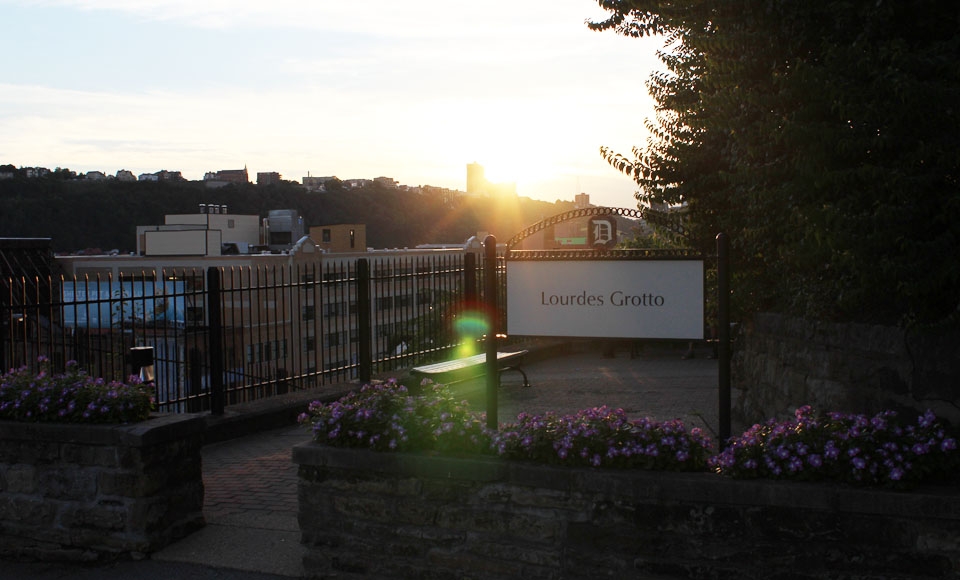

By Sydney McCabe | The Duquesne Duke
Cloaked in moss and nestled in a far corner of campus away from the hustle and bustle of A-Walk, the Grotto provides the perfect spot for prayerful meditators, day-dreamers, stress-relief seekers and sunset watchers alike. But despite the frequent visits it receives, many Duquesne students have little to no idea when, why or how the Grotto came to our little Bluff.
The Grotto, also known as Lourdes Grotto, is located behind Old Main, overlooking the Monongahela River and the South Hills. The strategic location was hand-picked by then university president Rev. Vernon Gallagher, explained Thomas White, the university’s archivist. At the time, he said, Duquesne more closely resembled a friendly neighborhood than a college campus.
This was partially the motivation behind bringing the Grotto to Duquesne. Rev. Gallagher had a vision of expanding and beautifying the university property and is credited with designing the campus layout we recognize today.
“Before his work began, the Bluff consisted of Old Main, Canevin Hall, the old Rangos building and several neighborhood homes that had been converted into department offices,” White said. “We owe most of what we know as ‘the Bluff’ to him.”
The Grotto serves as a replica of the original “Our Lady of Lourdes” statue in Lourdes, France. According to the Sanctuary of Our Lady of Lourdes official website, the original grotto was inspired by the story of the Marian Apparitions in Lourdes, which began when a 14-year-old girl named Bernadette Soubirous spoke of a woman she met in a cave while gathering firewood.
Bernadette claimed to see the woman, who identified herself as “The Immaculate Conception,” a total of 18 times that year. During the visits, the woman instructed Bernadette to pray for the conversion of sinners. The site was later converted into a grotto, which was then replicated on our very own bluff.
For Rev. Gallagher, building the Lourdes Grotto was not only an opportunity to beautify the campus, but it also represented an opportunity for bringing students and the community together.
“President Gallagher was really the first one who knew how to go out into the community and get money from people for campus projects,” White said. “He also picked a project that would benefit and include the student body.”
Plans for the statue, as well as instructions and stones, were purchased from The Edward O’Toole Company, Inc. However, all of the work was completed by Spiritan brothers and fathers, as well as various student organizations and faculty members. The members of Kappa Sigma Phi, a then-service society which no longer has a presence in Pittsburgh, were notable participants in the construction of the stone arc that shields the statues of Mary and Bernadette.
The statues themselves were imported from Italy. The figure of Mary arrived in 1956, but the Grotto was left unfinished, missing the sculpture of Bernadette for another year. Growing slightly impatient, President Gallagher sent a letter to the company alluding to the statue’s delay. The president joked with the company that perhaps the statue was one of the 46 casualties of the sinking of the Andrea Doria, an Italian ocean liner that sank near Massachusetts in 1956.
The Bernadette statue did arrive, however, in late 1957, and The Grotto was completed to the form we know, love and escape to today. The completion of The Grotto also marked a new era whereby students and faculty alike were inspired by the message of Bernadette and Mary.
Rev. Dan Walsh, a Spiritan priest who just celebrated 25 years of service at Duquesne, said The Grotto is a physical manifestation of Duquesne’s mission to bring scholasticism, spiritualism and service together.
“Here at Duquesne we start`ed a celebration on the feast of Our Lady of Lourdes, which is also the day for Prayer for the Sick,” he said. “We invited all the schools in the healing professions — pharmacy, nursing, PT, OT, Speech Language Pathology, Athletic Training and the health services to recall that they participate in the healing mission of Jesus Christ and the Church.”
The Grotto has even inspired some students to travel to Lourdes where they aided and prayed for the sick, said Rev. Walsh. The Grotto serves as not only a familiar escape but as a reminder of the Duquesne mission: to serve God by serving others.




